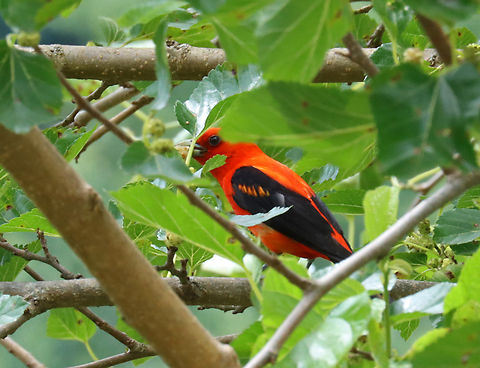
Appearance
The scarlet tanager, a mid-sized passerine, is marginally the smallest of the four species of "Piranga" that breed north of the Mexican border. It can weigh from 23.5 to 38 g, with an average of 25 g during breeding and an average of 35 g at the beginning of migration.Scarlet tanagers can range in length from 16 to 19 cm and from 25 to 30 cm in wingspan. Adults of both sexes have pale, horn-colored, fairly stout, and smooth-textured bills. Adult males are crimson-red with black wings and tail. The male's coloration is intense and deeply red, similar but deeper in shade than the males of two occasionally co-existing relatives, the northern cardinal and the summer tanager, both which lack black wings. Females are yellowish on the underparts and olive on top, with yellow-olive-toned wings and tail. The adult male's winter plumage is similar to the female's, but the wings and tail remain darker. Young males briefly show a more complex, variegated plumage intermediate between adult males and females.
Female, immature, and nonbreeding males may be distinguished from the same ages and sexes in summer tanagers, which are more brownish overall, and western tanagers, which always have bold white bars and more yellowish undersides than scarlet tanagers.
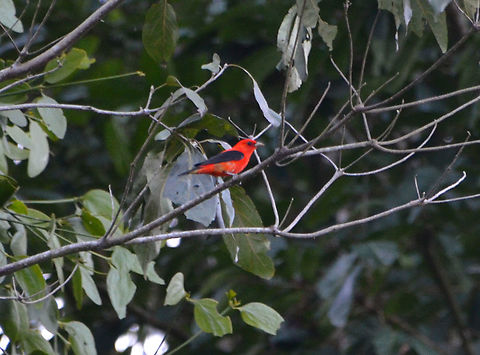
Naming
The genus name "Piranga" is from Tupi "Tijepiranga", the name for an unknown small bird, and the specific "olivacea" is from New Latin "olivaceus", "olive-green".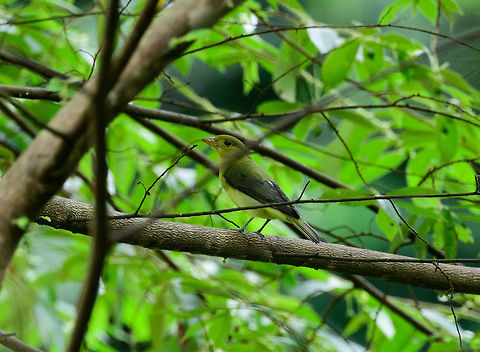
Behavior
The song of the scarlet tanager sounds somewhat like a hoarser version of the American robin's and is only slightly dissimilar from the songs of the summer and western tanagers. The call of the scarlet tanager is an immediately distinctive "chip-burr" or "chip-churr", which is very different from the "pit-i-tuck" of the summer tanager and the softer, rolled "pri-tic" or "prit-i-tic" of western tanager.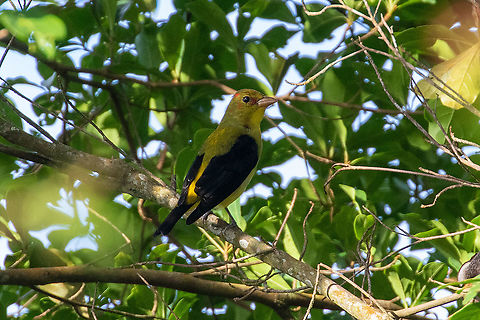
Habitat
Their breeding habitat is large stretches of deciduous forest, especially with oaks, across eastern North America. They can occur, with varying degrees of success, in young successional woodlands and occasionally in extensive plantings of shade trees in suburban areas, parks, and cemeteries. For a viable breeding population, at least 10 to 12 hectares of forest are required. In winter, scarlet tanagers occur in the montane forest of the Andean foothills. Scarlet tanagers migrate to northwestern South America, passing through Central America around April, and again around October. They begin arriving in the breeding grounds in numbers by about May and already start to move south again in midsummer; by early October, they are all on their way south. The bird is an extremely rare vagrant to Western Europe.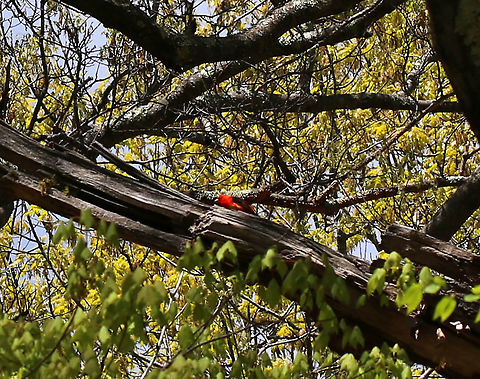
Reproduction
Male scarlet tanagers reach their breeding ground from mid-May to early June. Females generally arrive several days to a week later. Nest building and egg laying both occur usually in less than two weeks after the adults arrive. The clutch is usually four eggs, occasionally from three to five and exceptionally from one to six eggs may be laid.The eggs are a light blue color, often with a slight greenish or whitish tinge. Incubation lasts for 11 to 14 days. Hatching and fledging are both reached at different points in summer depending on how far north the tanagers are breeding, from June-early July in the southern parts of its breeding range to as late as August or even early September in the northernmost part of its range. The average weight at hatching is 3.97 g, with the nestlings increasing their weight to 20–22 g by 10 days, or 70% of the parent's weight.
The young leave the nest by 9–12 days of age and fly capably by the time they are a few weeks old. If the nesting attempt is disturbed, scarlet tanagers apparently are unable to attempt a second brood, as several other passerines can. In a study of 16 nests in Michigan, 50% were successful in producing one or more fledglings. In western New York, fledgling success increased from 22% in scattered patches of woods to as high as 64% in extensive, undisturbed hardwood forest.
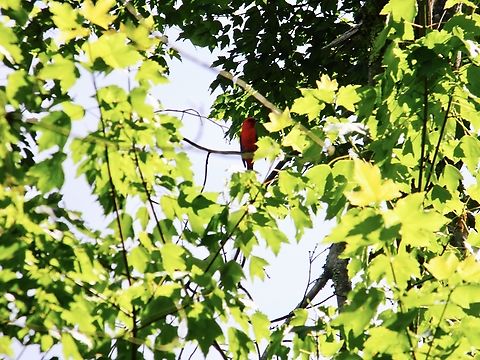
Food
Scarlet tanagers are often out of sight, foraging high in trees, sometimes flying out to catch insects in flight and then returning to the same general perch, in a hunting style known as "sallying". Sometimes, however, they also capture their prey on the forest floor.They eat mainly insects, but opportunistically consume fruit when plentiful. Any flying variety of insect can readily be taken when common, such as bees, wasps, hornets, ants, and sawflies; moths and butterflies; beetles; flies; cicadas, leafhoppers, spittlebugs, treehoppers, plant lice, and scale insects; termites; grasshoppers and locusts; dragonflies; and dobsonflies.
Scarlet tanagers also take snails, earthworms, and spiders. While summer tanagers are famous for this feeding method, when capturing bees, wasps, and hornets, scarlet tanagers also rake the prey against a branch to remove their stingers before consumption. Plant components of their diet include a wide variety of fruits that are eaten mainly when insect population are low: blackberries, raspberries, huckleberries, juneberries and serviceberries, mulberries, strawberries, and chokeberries.
References:
Some text fragments are auto parsed from Wikipedia.